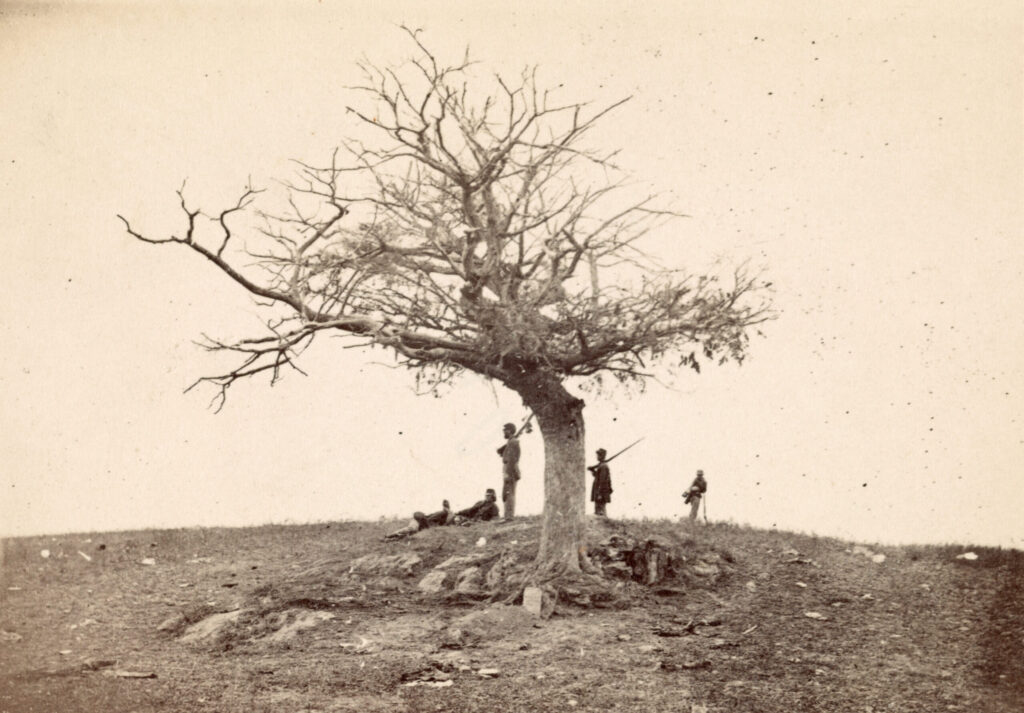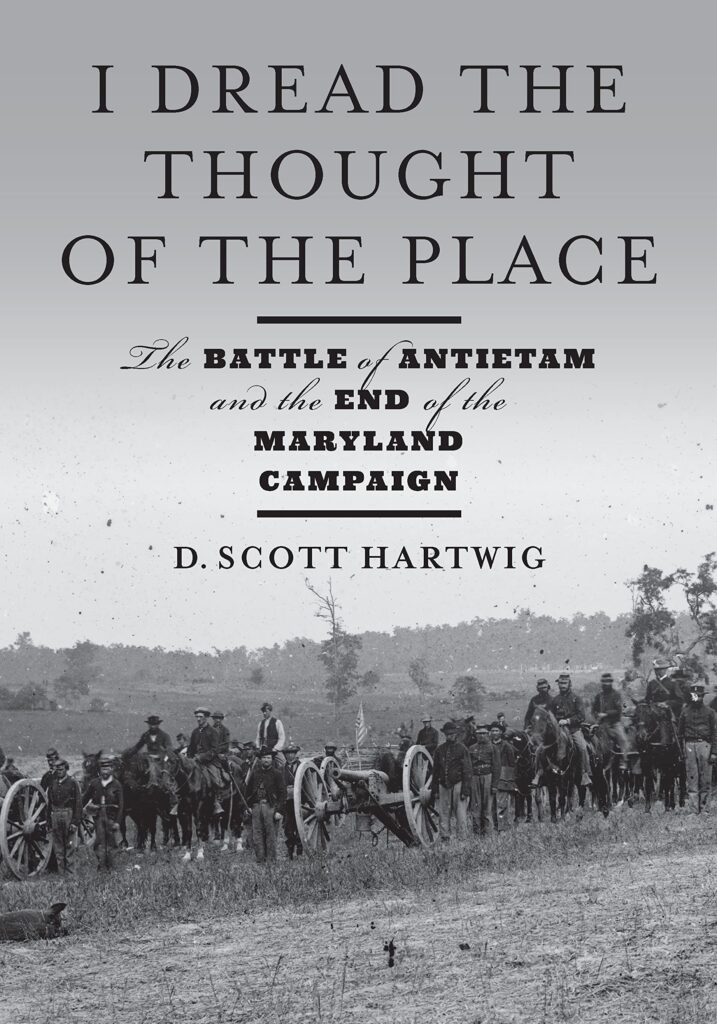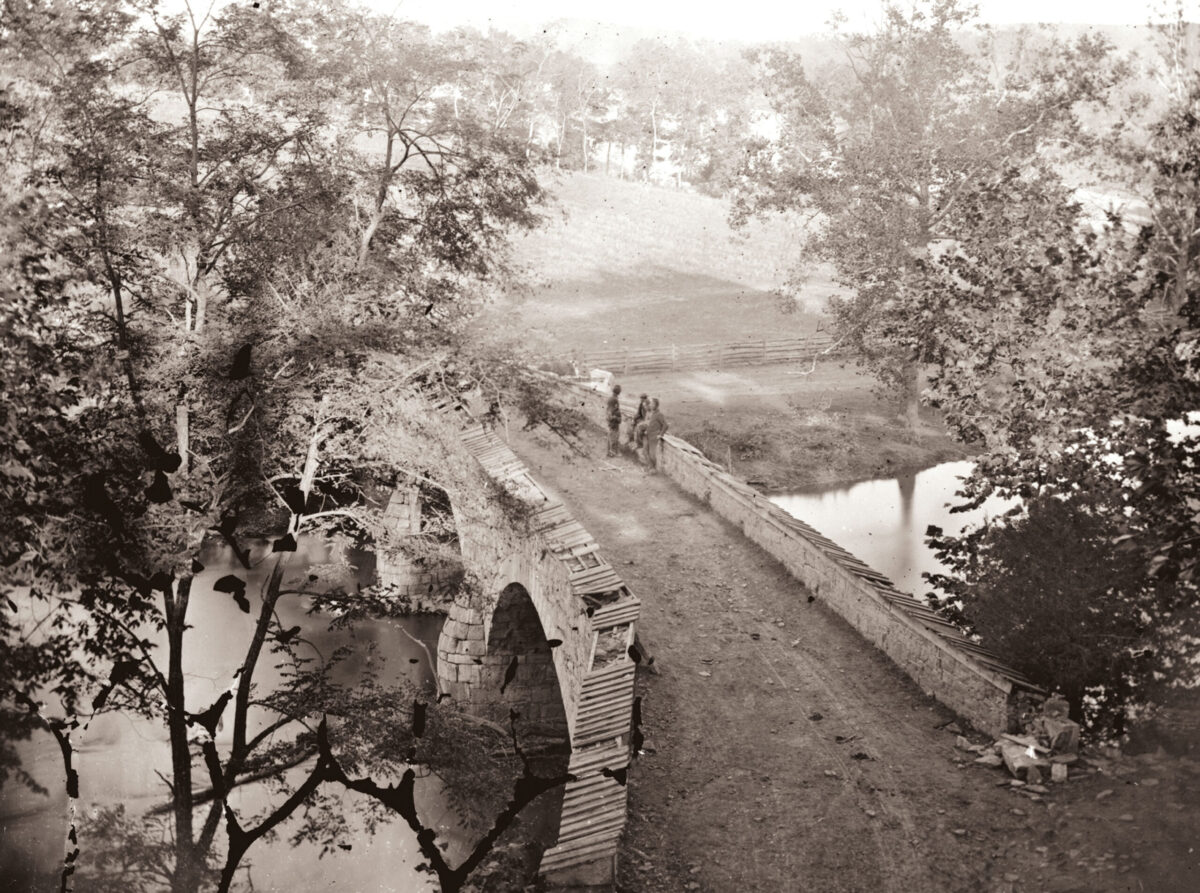The first volume of D. Scott Hartwig’s two-part chronicle of the September 1862 Maryland Campaign, To Antietam Creek, was published in October 2012. With Hartwig’s long-awaited second volume — “I Dread the Thought of the Place”: The Battle of Antietam and the End of the Maryland Campaign — now out, one might forgive the accomplished Civil War historian a respite of some sort. The September 17, 1862, clash between Robert E. Lee’s and George B. McClellan’s armies at Sharpsburg, Md., remains America’s bloodiest single day, and Hartwig provides here a remarkably intense, blow-by-blow study of a battle that produced more than 23,000 total casualties and forever changed the divided nation’s future. He recently sat down with Civil War Times for an exclusive discussion of his landmark study.

You of course established yourself as supervisory park historian at Gettysburg National Military Park? What was your inspiration for such a full-fledged study of the Maryland Campaign?
Several reasons. I never forgot Bruce Catton’s treatment of Antietam in Mr. Lincoln’s Army, and the battle had long intrigued me. When I became interested in writing this, there were only two real books on the battle/campaign, Francis Palfrey’s The Antietam and Fredericksburg and Jim Murfin’s A Gleam of Bayonets. Compared to Gettysburg, for such a major battle, Antietam was very lightly covered. That has since changed, but when I first started it was true.
With the second volume now out, any feelings of relief? How would you assess the entire project? How great a learning experience was it for you?
Relieved, yes, since it was a tremendous amount of work, but I also miss it. I enjoyed every day I worked on this book: one, because I enjoy the process of writing and creating something, and two, I learned something I didn’t know in every chapter I wrote. When you really get into the weeds of a historic event as I did with this project, you come to know the participants well and bringing their stories to life is in many respects the life blood of this book.
One of my goals was to write a book that a veteran of the battle might agree was an honest account. I had no agenda to write a book that was going to make sensational claims, I just wanted to tell the whole story, from Lincoln, McClellan, and Lee to the private soldier or a wife at home who learns her husband died at Antietam. I wanted this book to tell the whole story of Antietam, from the battle through its aftermath.
The research involved in crafting this chronicle seems to have extended to a level probably never before attempted by fellow historians. How surprised were you by some of the revelations that you uncovered?
I think much credit for the broad story I was able to reveal in this book goes to the publisher, Johns Hopkins University Press, who let me tell that story, even when it extended to more than 900 pages! What I wanted to create was a book that someone who had never read a Civil War book could enjoy and that someone who was steeped in the Antietam story could as well. So, it was important with each chapter not to get too bogged down in details but also to not simplify it so the richness of the story was diminished. It was also important to keep the focus on the people who lived this event, which I think ultimately is what most readers identify with when they read history. I was fortunate that Antietam was well-documented by those people.
For example?
There were plenty of revelations. All Civil War battles have narratives, often shaped during the late 19th century by former Union and Confederate officers writing for Battles and Leaders of the Civil War, Confederate Veteran, etc. Secondary historians frequently reinforced these narratives, some of which simply are not true, because they had relied on the primary published accounts of participants who often had an agenda.
One example I encountered was the narrative that the Army of Northern Virginia was this hardcore, outnumbered, shoeless band that fought the overwhelming juggernaut of the Army of the Potomac to a standstill. The Army of Northern Virginia did indeed fight extremely well at Sharpsburg, but the reason the army was so small was because thousands of soldiers were absent from the ranks, as the Confederate logistical system had utterly broken down, which in turn broke the soldiers down because they lacked adequate food, shelter, and clothing.
This fatigue impacted the army’s staying power during the battle. By the battle’s close, 21 of the army’s 39 infantry brigades had been rendered essentially combat ineffective. This was a level of damage the army would not experience again until the spring of 1865.
Give us an objective assessment of the command performances of both McClellan and Lee during the battle?
Lee performed extremely well. He had an excellent sense of when to move his very limited reserves and where, and he was willing to accept risk in these movements. The result was that at almost every point of major combat on the field Confederate numbers were near on par with Union strength. He also made effective use of his artillery, which saved the center after the Sunken Lane line was broken. Critics of Lee, however, can make the argument that he seemed oblivious to the physical condition of his army and took an enormous risk for minimal gain — because of the condition of his army — by offering battle at Sharpsburg.
McClellan’s performance is mixed. He did not do as badly as his detractors would have us believe and did not perform as well as his defenders claim. To understand how McClellan fights the battle, you must realize that he believed the Confederate army outnumbered him and took a great risk in initiating the offensive against it. His decisions make sense when you realize this.
In your opinion, where was the battle truly won or lost?
Tactically, Antietam was a drawn battle, but operationally McClellan won because he achieved his operational goal of driving the Rebel army out of Maryland. Lincoln made Antietam a strategic victory when he issued the Emancipation Proclamation.
If I were to point to a specific moment of the battle that was a crucial turning point, it would be Maj. Gen. Edwin Sumner’s disastrous decision-making. His mismanagement of John Sedgwick’s division resulted in the destruction of that fine division, which greatly shook Sumner and caused him to lose his command perspective and imagine that the entire Union right flank was shaken and imperiled. This, in turn, fed into McClellan’s fears of a major enemy counterattack and led him to send his most important reserve, the 6th Corps, to reinforce the army’s right. Had he sent them to reinforce the breakthrough at the Sunken Lane, or Maj. Gen. Ambrose Burnside in his assault on the Confederate right, that might have proved decisive.
Tell us more about Maj. Gen. Joseph K.F. Mansfield — his role in the battle, his death, and its impact on the battle itself.
Mansfield had been a soldier for 40 years at Antietam, but he was an engineer and staff officer with relatively little experience commanding troops when he was assigned to command the 12th Corps. He took command on September 15 and made an immediate impact. His soldiers quickly detected he cared about their welfare. But on the morning of the battle, he insisted that all the regiments of his corps advance to the front in a formation known as “column of companies” or “double column of companies.” Imagine each regiment looked something like a Greek phalanx. It was an effective formation for command and control but not if the unit might be exposed to artillery fire. Brigadier General Alpheus Williams, Mansfield’s second in command, begged to be allowed to deploy the regiments into line of battle, but Mansfield stubbornly refused because he believed the numerous new regiments in his corps would run away.
Mansfield also fumbled the initial deployment of the corps, largely through his inexperience. Very early in the fight, he observed the 10th Maine firing on someone in the East Woods and, believing they were firing on friendly troops, rode in front of the regiment to get it to cease fire. Maine officers and men pointed to Rebels in the woods they were firing at. Mansfield was shot and mortally wounded. One of the first things Alpheus Williams did upon taking command in place of Mansfield was to deploy the regiments of the corps.
As a side note, there was controversy after the war on whether Mansfield was mortally wounded in front of the 10th Maine or 125th Pennsylvania, but the evidence is overwhelming that it was in front of the 10th Maine.
Did your research provide you with new opinions of any of the lesser-known commanders on either side?
Part of what I enjoyed in writing this book was telling the story of lesser-known officers, some of whom failed utterly and others who distinguished themselves but received little credit. William Robbins, the senior captain of the 4th Alabama, was one. He did a superb job defending the East Woods after his regiment, along with the 5th Texas and part of the 21st Georgia, captured it during John Bell Hood’s counterattack. Neither Hood nor Law ever understood what Robbins did, so he received no mention in their after-action reports.
Another officer was Captain Hiram Dryer, commanding the 4th U.S. Infantry. Dryer was the senior officer of the Regular Army battalions that were sent across Antietam Creek to support the Union horse artillery batteries that crossed at the Middle Bridge. Employing excellent tactics that the Regulars excelled in — fighting as skirmishers — he cleared nearly all the Confederate forces on the northern end of Cemetery Hill and almost certainly would have secured the position had he not be recalled by General George Sykes, who was angry that Dryer had exceeded his orders, and was fearful the Rebels had large forces arrayed behind the hill, which they did not.
You give General Robert Rodes notable credit for helping establish the Confederate defense in the Sunken Lane.
Rodes had been ordered to join the brigades of D.H. Hill’s Division sent to reinforce the Confederate left. But he observed that those brigades had been defeated and badly broken and recognized that the Sunken Lane offered the only real defensive position in the Confederate center if the enemy attack extended in that direction. D.H. Hill and George B. Anderson also recognized this, which is why a defensive line was formed here.
You must be satisfied that your book’s format allowed inclusion of countless intriguing anecdotes that likely would be excluded from shorter studies.
Yes, I am very grateful that Hopkins gave me the flexibility to tell these stories. In some sense, they are the heart of the book — the common person placed in extraordinary circumstances. Some are heroes, for others their courage utterly fails them, and most simply are trying to survive and cope with an incredibly frightening, shocking experience.
Union Brig. Gen. John Caldwell later received credit for his leadership at Gettysburg but was highly criticized for his “erratic” performance at Antietam while commanding the 1st Brigade in Israel Richardson’s 1st Division in Sumner’s 2nd Corps.
Not all generals or soldiers were consistent in their performances on the battlefield. They were human, after all. For some it was the stress of command that might erode performance; others, like Gouverneur K. Warren in 1864, may have suffered from depression or a bipolar personality, which incessant combat and stress made worse. In Caldwell’s case, we simply do not know what happened. He performed poorly at Antietam, exercising little command over his brigade, and being seen well to the rear of his troops, and nearly being dismissed from the service. But then he performed very well at Gettysburg handling the 1st Division in a difficult counterattack there.
There clearly was some doubt about him, though, which explains why he was relieved of command in the Army of the Potomac’s reorganization in the spring of 1864. Winfield Hancock wrote to Meade at the time that he did not believe that Caldwell had the capability to command a division in the upcoming campaign. Perhaps Hancock was unfair, but he knew well what would be expected of his commanders in the coming months.
How monumental a setback was the loss of Israel Richardson for the Union Army, both in the battle and the war?
It was significant. Richardson was a tough and aggressive fighter, an upfront type of soldier who had the loyalty and devotion of his troops. However, without artillery support it is hard to imagine what he could have done to crack open Lee’s center. Lee had massed significant artillery along Reel Ridge, which could maul any infantry advance beyond the Sunken Lane. Unless Richardson could have been reinforced with several rifled batteries that could have engaged the Confederate artillery, there was not much his infantry could do to exploit the capture of the Sunken Lane. It was a Union command failure to not perceive the opportunity here and send Richardson the resources he needed. He managed to get only a single battery of smoothbores, which lacked the range to reach the Southern guns, and he was mortally wounded trying to direct their fire.
Meanwhile, Sumner had massed so much artillery on the Union right — including all the divisional artillery of French and Richardson — that there were rifled batteries sitting in reserve. This was a case where army headquarters should have intervened to move the guns that could help Richardson, but they were more concerned about the potential of a major Confederate attack against the right and hesitated to weaken the artillery there in any manner.

Did McClellan and Porter mishandle the significance of the Middle Bridge in their battle plan?
I do not think so. The Middle Bridge was never a point at which McClellan contemplated anything more than a demonstration, the reason being the ground west of the creek when you get past Newcomer Ridge was completely exposed to the Confederate guns on Cemetery Hill and Cemetery Ridge. What McClellan and Porter fumbled was the unforeseen opportunity that Captain Hiram Dryer’s advance with the U.S. Regular infantry created. Both were concerned the Rebels might have large forces in rear of the hill and ridge, but Porter was also concerned about a lack of support on the right from the 2nd Corps. George Sykes, who commanded the division including the regulars, was deeply worried about a large enemy force concealed in Sharpsburg and was the one who ordered Dryer to cease his advance and withdraw. Porter did eventually sense an opportunity was at hand, but by the time he considered reinforcing the Regulars across the creek, Sykes had already ordered their withdrawal.
A crucial element of success in battle is to sense when and where opportunities exist and to seize them quickly. It is not easy to do because of many factors — confusion, smoke, terrain — but the most successful commanders in history have had a knack for grasping these moments.
You note that the Union attackers at the Rohrback Bridge rarely receive deserved credit. Explain.
The narrative that has developed around the effort to capture the bridge is that all the attempts were futile and exposed Burnside as a fool who could not conceive anything but a frontal assault. But Burnside did not want to make a frontal assault, hoping to outflank the bridge’s defenders, yet circumstances that are too involved to go into here forced him to attack the bridge head-on.
When you examine each assault from the tactics of infantry at the time, the weapons they have, and the situation, they make sense. The infantry commanders were not stupid, but it was an extremely difficult position to assault both because of the terrain and because Henry Benning had set up an excellent defense. Tremendous courage was displayed in each attack, which is often forgotten in the desire to condemn Burnside, and the final effort carried the bridge.
What is often left out of the successful final attack is that Hugh Ewing’s Ohio brigade had crossed the creek at a ford below the bridge and threatened to roll up Benning’s right flank at the bridge. This greatly helped the 51st New York and 51st Pennsylvania.

‘I Dread the Thought of the Place’
The Battle of Antietam and the End of the Maryland Campaign
By D. Scott Hartwig, Johns Hopkins University Press, 2023
If you buy something through our site, we might earn a commission.
It seems surprising, as you note, that the participants in A.P. Hill’s march from Harpers Ferry to Sharpsburg had little to say about their legendary march that day. Explain.
Hill’s men had made more difficult marches in the campaign and in the Second Manassas Campaign, so they may not have seen this one as all that significant. Legend has us imagining that Hill’s men made this march at nearly a jog, which was not the case. They covered about 2½ mph, which is good for an entire infantry division but not remarkable. What made the march difficult was that it was warm and Hill only made a few brief halts to rest the men.
Hill had to balance reaching the field as quickly as possible but with as many of his men as he could. Had he driven his men — as the legend implies he did — at something like 3 mph without halts, he would have lost hundreds of men to straggling. So he settled on a compromise. He marched quickly, but not so quickly that he broke his men down, and ordered less halts than was customary — typically units marched 50 minutes and rested 10 — but enough to give his men just enough rest that most endured the march.
Even with this, Hill had several hundred men break down and straggle during the march, but it was not enough to impair the striking power of the division.
Controversy remains on the decision by McClellan not to renew the Union attack on September 18. Was it the right choice?
I do not think so, but with that said, I also do not think the army was in a condition for a general attack along the line. William B. Franklin, the 6th Corps commander, had come up with a good plan to assault and capture Nicodemus Heights, which he believed — I think correctly – would render the Confederate position in the West Woods untenable. It was the best point along the Union front to attack. The Federals had the fresh 6th Corps in position with overwhelming artillery support. A successful attack would not have destroyed Lee’s army, but it might have inflicted further damage on that army which had been hurt badly on September 17, or hastened its retreat to Virginia. But as I mentioned earlier when you understand that McClellan believed he faced superior numbers, his decision to not attack on the 18th makes sense. He wanted the reinforcements of Darius Couch’s and Humphreys’ divisions before he attacked again. If he had a better estimate of enemy strength, he might have carried out Franklin’s plan, but one of McClellan’s great failings as a commander was to never assemble accurate intelligence on enemy strength and capabilities.
The tactical triumph at Antietam, as you note, provided Lincoln the opportunity to address slavery as a war aim. From reading various accounts and correspondence, did you get the impression the common soldier and commanders in the Army of the Potomac shared the president’s enthusiasm?
I found opinions in the army were divided along political lines. Most Democrats opposed the Emancipation Proclamation, while Republicans supported it. However, I also found that although most Democrats were against Emancipation as a war policy, the proclamation did not diminish their determination to defeat the Rebels. There were also soldiers who had not formed a decisive opinion about Emancipation yet and took a wait and see attitude.
historynet magazines
Our 9 best-selling history titles feature in-depth storytelling and iconic imagery to engage and inform on the people, the wars, and the events that shaped America and the world.






